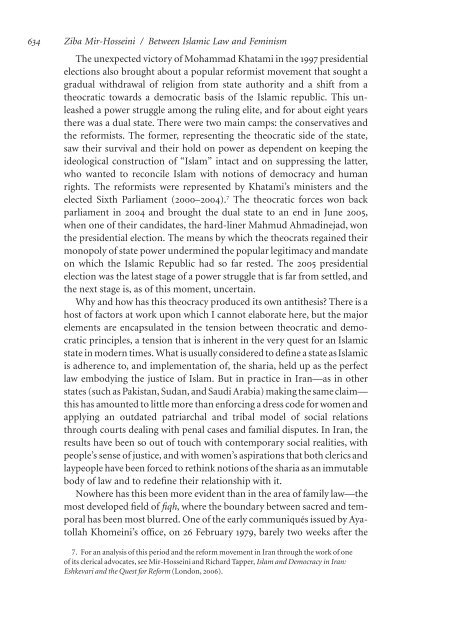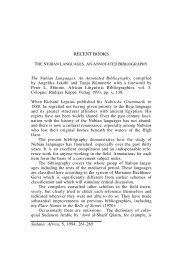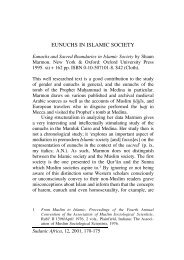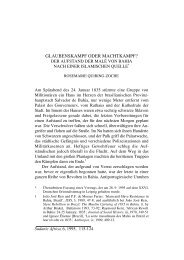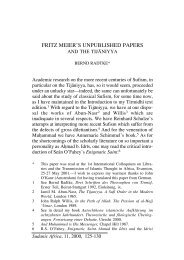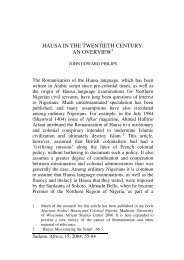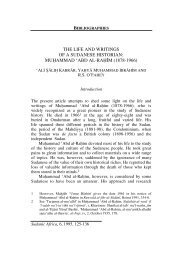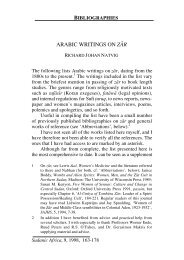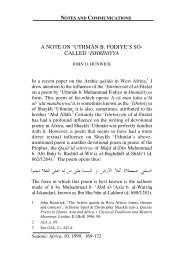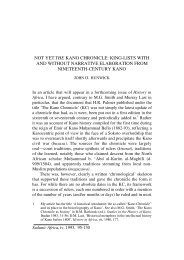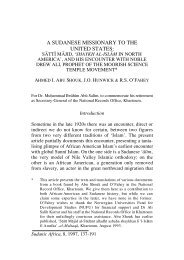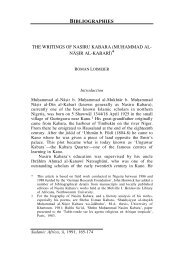Muslim Women's Quest for Equality: Between Islamic Law and ...
Muslim Women's Quest for Equality: Between Islamic Law and ...
Muslim Women's Quest for Equality: Between Islamic Law and ...
Create successful ePaper yourself
Turn your PDF publications into a flip-book with our unique Google optimized e-Paper software.
634 Ziba Mir-Hosseini / <strong>Between</strong> <strong>Islamic</strong> <strong>Law</strong> <strong>and</strong> FeminismThe unexpected victory of Mohammad Khatami in the 1997 presidentialelections also brought about a popular re<strong>for</strong>mist movement that sought agradual withdrawal of religion from state authority <strong>and</strong> a shift from atheocratic towards a democratic basis of the <strong>Islamic</strong> republic. This unleasheda power struggle among the ruling elite, <strong>and</strong> <strong>for</strong> about eight yearsthere was a dual state. There were two main camps: the conservatives <strong>and</strong>the re<strong>for</strong>mists. The <strong>for</strong>mer, representing the theocratic side of the state,saw their survival <strong>and</strong> their hold on power as dependent on keeping theideological construction of “Islam” intact <strong>and</strong> on suppressing the latter,who wanted to reconcile Islam with notions of democracy <strong>and</strong> humanrights. The re<strong>for</strong>mists were represented by Khatami’s ministers <strong>and</strong> theelected Sixth Parliament (2000–2004). 7 The theocratic <strong>for</strong>ces won backparliament in 2004 <strong>and</strong> brought the dual state to an end in June 2005,when one of their c<strong>and</strong>idates, the hard-liner Mahmud Ahmadinejad, wonthe presidential election. The means by which the theocrats regained theirmonopoly of state power undermined the popular legitimacy <strong>and</strong> m<strong>and</strong>ateon which the <strong>Islamic</strong> Republic had so far rested. The 2005 presidentialelection was the latest stage of a power struggle that is far from settled, <strong>and</strong>the next stage is, as of this moment, uncertain.Why <strong>and</strong> how has this theocracy produced its own antithesis? There is ahost of factors at work upon which I cannot elaborate here, but the majorelements are encapsulated in the tension between theocratic <strong>and</strong> democraticprinciples, a tension that is inherent in the very quest <strong>for</strong> an <strong>Islamic</strong>state in modern times. What is usually considered to define a state as<strong>Islamic</strong>is adherence to, <strong>and</strong> implementation of, the sharia, held up as the perfectlaw embodying the justice of Islam. But in practice in Iran—as in otherstates (such as Pakistan, Sudan, <strong>and</strong> Saudi Arabia) making the sameclaim—this has amounted to little more than en<strong>for</strong>cing a dress code <strong>for</strong> women <strong>and</strong>applying an outdated patriarchal <strong>and</strong> tribal model of social relationsthrough courts dealing with penal cases <strong>and</strong> familial disputes. In Iran, theresults have been so out of touch with contemporary social realities, withpeople’s sense of justice, <strong>and</strong> with women’s aspirations that both clerics <strong>and</strong>laypeople have been <strong>for</strong>ced to rethink notions of the sharia as an immutablebody of law <strong>and</strong> to redefine their relationship with it.Nowhere has this been more evident than in the area of family law—themost developed field of fiqh, where the boundary between sacred <strong>and</strong> temporalhas been most blurred. One of the early communiqués issued by AyatollahKhomeini’s office, on 26 February 1979, barely two weeks after the7. For an analysis of this period <strong>and</strong> the re<strong>for</strong>m movement in Iran through the work of oneof its clerical advocates, see Mir-Hosseini <strong>and</strong> Richard Tapper, Islam <strong>and</strong> Democracy in Iran:Eshkevari <strong>and</strong> the <strong>Quest</strong> <strong>for</strong> Re<strong>for</strong>m (London, 2006).


